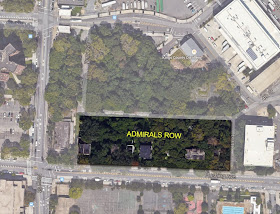 |
| Google Aerial of SW Corner of Brooklyn Navy Yard at Flushing and Navy |
|
|
|
||||||
|
|
|
The Navy Yard closed in 1966; however, the residences along Admiral’s Row remained occupied by national guardsmen until the 1970’s. Once the houses were abandoned the copper pipes were looted, homeless sometimes squatted in the buildings and feral dogs roamed the site.[3] After the redevelopment of the Navy Yard began, the homeless and feral dogs were evicted and the site was secured. However, since the 70’s neglect of Admiral's Row has been constant and nature continues to ravage the structures.
Preservationists from Fort Greene and Pratt have lobbied for the restoration of Admiral’s Row while the Brooklyn Navy Yard Development Corporation, who owns the site, has tried unsuccessfully to have a shopping center built where the houses currently sit.[4] Although, according to Curbed another request for proposal (RFP) to develop the site into a grocery store was issued last July.[5] Included in the RFP is the requirement that one of the houses and a nearby woodshed be restored while the rest of the former residences are to be razed.[6] The Brooklyn Navy Yard Development Corporation has done an admirable job promoting the preservation of other structures within the yard but when developers propose demolishing historic, albeit dilapidated houses to build a placeless “suburban shopping center” it’s no wonder that they are at odds with preservationists.
The Video above, from Vimeo user 2e, shows the interior of the houses along Admiral's Row
References:
- White, Norval, Willensky, Elliot, and Leadon, Fran AIA Guide to New York. Oxford University Press, 2010
- A Short History of the New York Navy Yard Acme Book Binding, 23 February, 1941
- Bleyer, Jennifer "Hopes Fade for Aging Beauties of Admiral's Row" New York Times (print) 21 August, 2005
- Crawford, Amy "Prat Professors Seek To Reconcile Competing Plans for 'Admirals Row'" Brooklyn Daily Eagle 4 March, 2008
- "Plan to Redevelop Admirals Row Lives" Curbed July 2014
- Geiger, Daniel "Brooklyn Navy Yard's Admiral's Row Back in Play" Crain's 7, July 2014








